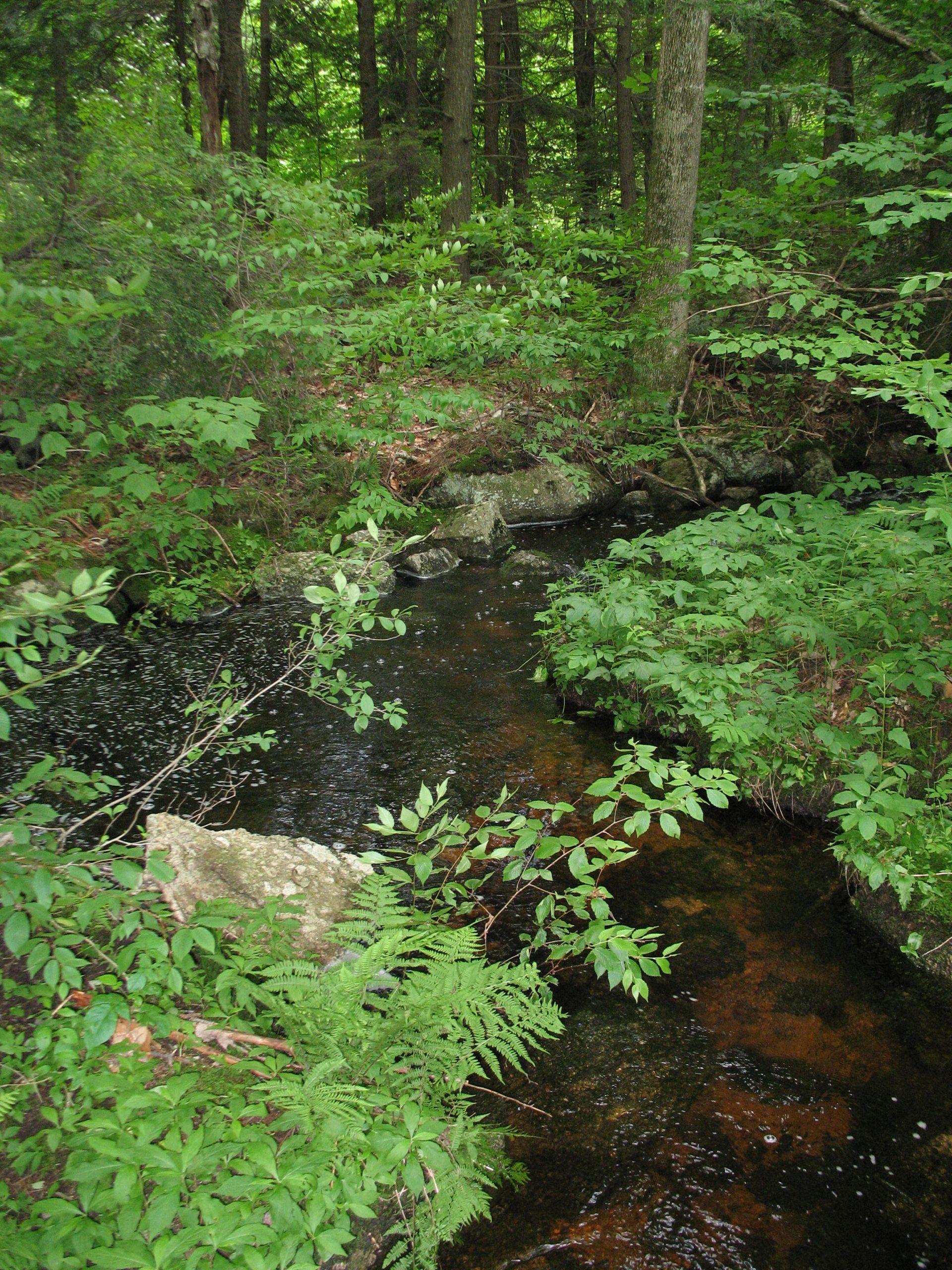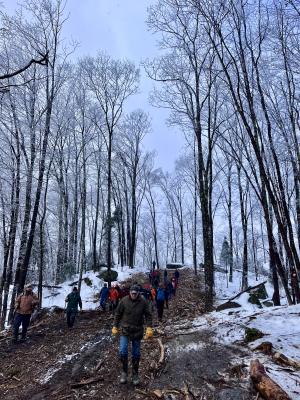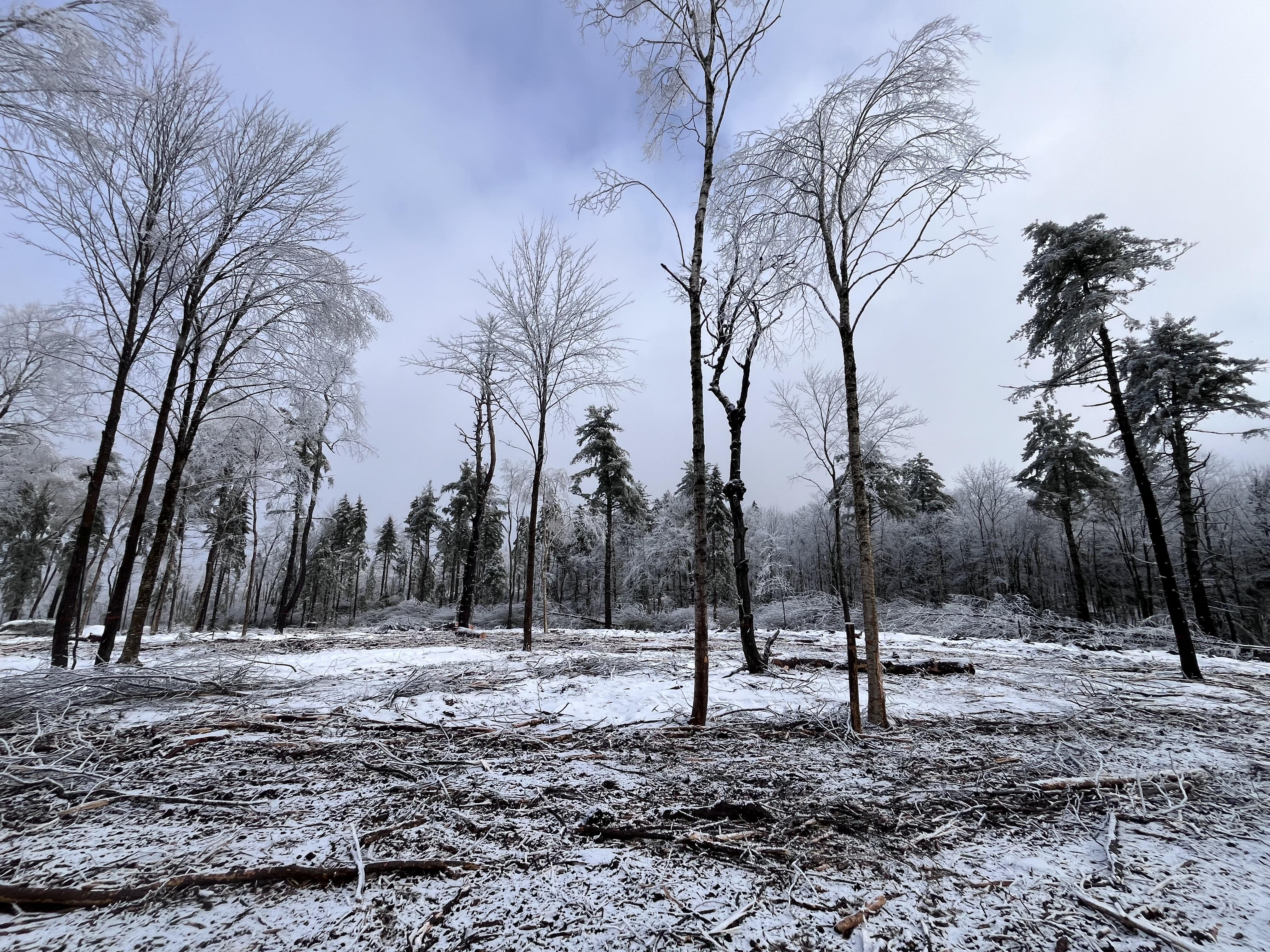- Tags:
- Working Forests,
- Forestry


The Forest Society’s foresters incorporate practices designed to address climate adaptability and resilience in the forest management plans formulated for each property, including measures to prepare for more frequent extreme weather events like intense rain, windstorms, and drought. Global trade and milder winters have compounded these natural hazards through the introduction and increased survival of forest pests.
While every forest will face these challenges, the Forest Society recently had the opportunity to participate in a demonstration project centered at the Charles L. Peirce Wildlife and Forest Reservation in Stoddard and Windsor, one of the largest Forest Society properties.
The Charles L. Peirce Wildlife and Forest Reservation lies in the heart of a 100,000-acre intact forest block in southwest New Hampshire. At almost 4,000 acres, the property includes a variety of forest and habitat types, including patches of old growth forest, as well as areas lacking the species diversity that will prove to be important as the climate changes.
The property was given to the Forest Society in the late 1970s and was later encumbered by a conservation easement that placed a “forever wild” designation on 80 percent of the acreage, thus excluding it from active forest management that can help make the property resilient in the future. The remaining acreage that is open to forest management, nearly 800 acres, is located in several large blocks across the property.
In 2023, Forest Society Managing Forester Wendy Weisiger and her team joined a group of land managers, foresters, and climate scientists, coined the Climate Resilient Forest Management (CRFM) network, to think about how they might manage lands, specifically in the context of climate change, at a landscape level. Funded by a National Fish and Wildlife Foundation grant, organized by The Nature Conservancy, and led by Northern Institute of Applied Climate Science (NIACS) and University of Vermont Forestry, the group developed targeted climate resilient management plans for projects guided by NIACS’s Forest Adaptation Workbook. The project included plans for how to implement management practices and then share takeaways from each project at future group meetings. The following article, written by Field Forester Ben Aldrich, summarizes some of the methods the team used during the Peirce Reservation project.
In winter 2024, the Forest Society initiated a climate-adaptive forest management project on a 140-acre stand at the Peirce Reservation. The trees in the project area, known as the Wright Pasture, had received little to no management after regenerating on abandoned pastures and heavy cutting in the 1950s. The result was an even-aged stand with little understory regeneration, high levels of unacceptable growing stock, and a mix of tree species that were not all well-suited for the site. This made the stand even more vulnerable to stressors expected in a warmer climate, such as drought, windstorms, pests, and disease. In their forest inventory, foresters Gabe Roxby, formerly of the Forest Society, and Steve Junkin developed four separate harvest prescriptions for this stand based on site conditions. In 2023, Forest Society foresters met with consulting foresters from Full Circle Forestry on site to discuss and refine the prescriptions. Over the summer of 2023, Full Circle marked the area for harvest. The following sections describe how the goals for adapting the forest to meet the threats of climate change were addressed.

Improve Individual Tree Vigor Through Thinning
In the lower portion of the Wright Pasture, where younger trees were growing, foresters decided to remove, or thin, lower quality trees to improve the vigor of remaining trees they wanted to cultivate. This presented several challenges to the consulting foresters responsible for marking which trees loggers should cut and which trees should remain. Foresters had to pick trees to cut that would make space—or release—the crowns of the remaining trees while not shining too much light on the stems. Introducing too much light can trigger sprouting of dormant buds, also known as epicormic sprouting, which degrades the wood quality. Epicormics also indicate trees are under stress and are competing for resources. The oak on this site was extremely sensitive to sprouting after disturbances, such as a timber harvest or windstorm. By analyzing the annual growth rings on stumps of the cut trees, foresters noted that growth in the stressed trees had slowed under the dense canopy conditions.
The next challenge foresters faced was to maintain the overall diversity of the stand, which was done by retaining less abundant species such as cherry and yellow birch. Thinning improves resilience by allowing more growing space to the best-suited trees, which improves their vigor and reduces competition for water, nutrients, and light. This makes the trees more resistant to drought-related mortality, a disturbance that will increase in frequency and duration as the climate warms. Climate change also increases the likelihood of another common forest disturbance: wind events. Thinning addresses this by increasing the stability of the trees. Finally, maintaining species diversity acts as a hedge against forest pests and diseases such as spongy moth, emerald ash borer, and beech leaf disease, similar to how a stock portfolio decreases the
risks associated with investments through diversification.
Transition to Uneven-aged Management
In the upper part of the stand, the land use history created different conditions. This area, bordered by stone walls, was used as a pasture by local sheep farmers before abandoning the pasture more than 100 years ago. The forest regenerated in open light conditions, which allowed the pines to be attacked by the white pine weevil. This resulted in the trees growing in the distinctive multi-trunked wolf pine shape, which makes them susceptible to snapping and breaking in high winds and unsuitable for forest products. The foresters determined the best course of action was to initiate a regeneration harvest in the former pasture while maintaining a partial overstory with an irregular shelterwood prescription. The variable site conditions favored an irregular approach where the intensity of the cutting depended on the availability of advanced regeneration, overstory species composition, and soil suitability for seedling establishment of desirable species. Creating multiple age classes improves forest resilience by ensuring that when disturbances occur, a new generation is waiting in the understory to take its place.

Transition to a More Resilient Composition
The variable canopy cover within the shelterwood harvest creates a variety of shading conditions facilitating the regeneration of species across a spectrum of degrees of light tolerance. Windfirm pine with large crowns and climate-adapted hardwoods were retained to serve as both seed and shade trees to facilitate the establishment of a new cohort of trees better adapted to a warmer climate. On wetter soils, yellow birch, a species with moderate shade tolerance, were favored for regeneration, while the drier sites were favored for pine and other hardwood species. Less abundant species, such as black cherry, were retained for their wildlife mast value and adaptability. Under current climate projections, the growing conditions in southwestern New Hampshire are shifting to be more suitable for black cherry. Expanding the tree species diversity further works toward the Forest Society’s goal of creating a more climate-adapted forest.
Under mixed competition, the species least adapted to a warmer climate compete poorly with the better-adapted species in the canopy of a mature forest. The more species present, the higher the likelihood that the mature forest will have a composition that is more resilient to climate-induced stressors. Mutualistic interactions between species can also occur when the species mix cooperates to cope with stressors such as drought. This is demonstrated by the dispersal of water from deep-rooted species to the upper soil layers where it can be reached by shallow-rooted species, known as hydraulic lift. Mixed species forests have also been shown to be more resistant to insect damage and fungal pathogens by slowing the rate of spread. Wind resistance is also improved in mixed-species forests through higher growth efficiency, resulting in more stable trees with larger crowns.
Mixing forests is a valid strategy to combat the forest senescence observed in monocultures around the world as the climate warms. During my studies in Central Europe, I was exposed to the devastating effects a multi-year drought can have on monoculture forests, where I observed entire landscapes of dead trees killed by bark beetle. In the Rocky Mountains, climate change has increased the vulnerability of the forests to Mountain pine beetle infestations and fires, effectively deforesting a large swath of the landscape. Fortunately, the forests of the Northeast have much higher species richness than other economically important forest areas in the world.
Protection of Vulnerable Species
Climate change will shift species distributions to higher elevations and latitudes (in the northern hemisphere). Two species facing different types of threats, red spruce and white ash, were the focus of strategic protection during the Peirce project.
Ash are threatened by a novel pest, the emerald ash borer (EAB), whose larvae feed on the cambium resulting in tree mortality. To retain ash on site, moderately sized openings were created in wetter, enriched soils in both harvest areas to create favorable sites for ash seedling establishment. While mature ash are susceptible to EAB, the smaller diameter trees are ignored by the insects. The hope is that a new generation can be established and will mature at a time when the EAB population is under control.
Growing in the harshest Northeast environments, red spruce is exposed to high winds and snow loads at high elevations and can only thrive when competition from faster growing trees is hindered by the harsh winter. The spruce patches at Peirce are in danger of disappearing as winters warm. So to combat this and work to maintain the species’ distribution, patches of red spruce regeneration overgrown by hardwoods have been released. Feller-buncher operator Joey Hardwick went above and beyond in this task by cutting off the tops of small diameter hardwood saplings that were overtopping the spruce stems.
Management for Uncertainty
Relying on a single strategy to adapt to climate change would pose a significant risk to forests. Our management in this harvest was designed to address the uncertainties of climate change through a variety of strategies to improve the vigor of the remaining stand while creating a more resilient and diverse new cohort of trees. The results of this project will lie in contrast to the uncut wild land that exists on the majority of the Peirce Reservation. This is part of the scientific process that guides our decision making for future management. Establishing mixed-age stands with a diversity of species will also increase carbon sequestration resiliency. As carbon continues to be stored in the older wild lands, the newly established cohort of trees will maximize their carbon sequestration rate as they reach 30 to 70 years of age. The remaining legacy trees will continue to store large volumes of carbon and provide critical wildlife habitat. Through thoughtful and sustainable forest management, carbon can be sequestered and converted into durable wood products, extending carbon storage far beyond natural conditions. Working forests play an important role in fighting climate change. It’s a goal of the Forest Society to educate more landowners about the benefits and importance of climate-resilient forest management as a critical tool in proactively keeping forests healthy.
Learn more
Online
- In addition to the Peirce Reservation harvest, many other projects from across the country that are focused on climate resiliency and adaptation can be viewed at forestadaptation.org/adapt/demonstration-projects.
Forestry Glossary
- Cambium: Layer of living cells between the bark and the wood.
- Even-Aged Stand: All trees are the same age or at least the same age class. A stand is considered even-aged when the range of tree ages do not vary by more than 20 percent.
- Epicormic Sprouting: Branches that sprout from the main stem of the tree below the crown, lowering the value of the wood.
- Hydraulic Lift: Water in deep soil layers in the ground is pulled upward by roots and distributed in soil closer to the surface.
- Legacy trees: Usually mature, older trees left on-site after harvesting for biological, wildlife, spiritual, or aesthetic purposes.
- Mutualism: An association between species, where each derives their own benefit from the interaction.
- Regeneration: Seedlings and saplings that may come from seeds or vegetative sprouting.
- Shade Tolerance: Ability of trees to grow in shaded conditions.
- Shelterwood: A silvicultural practice, aimed at regenerating an area with partially shaded conditions.
- Thinning: A silvicultural practice that reduces the stand density primarily to improve growth, enhance tree health, or recover potential mortality.
- Unacceptable Growing Stock: Trees not suitable for valuable timber products due to form, rot, or lifespan.
- Windfirm: A term used to describe trees that have a higher crown to diameter ratio that will likely be less impacted by wind damage.
This article was originally printed in the summer 2024 issue of Forest Notes magazine.
